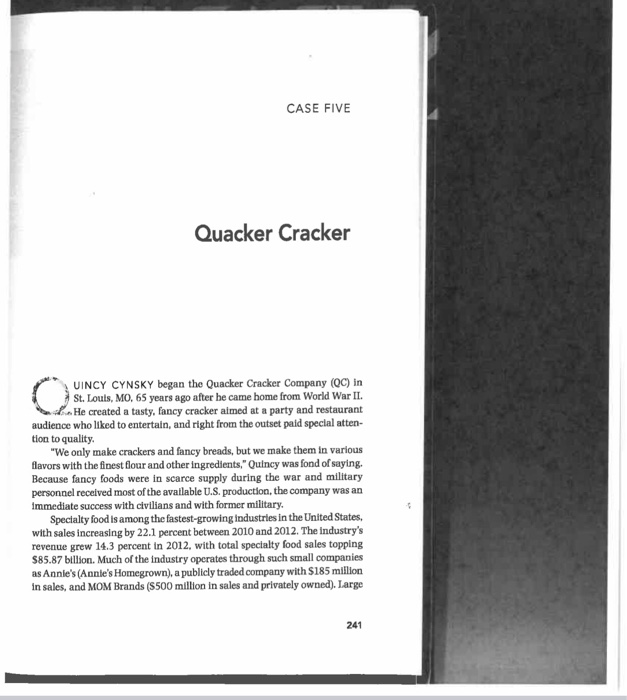QUESTION: calculate Current ratio, quick ratio, debt, average collection period, total asset turnover, and return on equity.
CASE FIVE Quacker Cracker UINCY CYNSKY began the Quacker Cracker Company (QC) in St. Louis, MO, 65 years ago after he came home from World War II. He created a tasty, fancy cracker aimed at a party and restaurant audience who liked to entertain, and right from the outset paid special atten- tion to quality, "We only make crackers and fancy breads, but we make them in various flavors with the finest flour and other ingredients," Quincy was fond of saying. Because fancy foods were in scarce supply during the war and military personnel received most of the available U.S. production, the company was an Immediate success with civilians and with former military. Specialty food is among the fastest-growing industries in the United States, with sales increasing by 22.1 percent between 2010 and 2012. The Industry's revenue grew 14.3 percent in 2012, with total specialty food sales topping $85.87 billion. Much of the industry operates through such small companies as Annie's (Annie's Homegrown), a publicly traded company with $185 million in sales, and MOM Brands (S500 million in sales and privately owned). Large 241 242 Quacker Cracker food companies contain specialty food segments, including Ralcorp ($4 billion in sales), a subsidiary of ConAgra Foods, and Smucker's, with sales of S6 billion. THE ATTITUDE TOWARD DEBT QC expects strong growth this year (assume that it is now January 2012) and Dianne McCabe, the chief financial officer (CFO), hopes she can make a case for borrowing to finance the company's expansion. She realizes, however, that she is likely to face stiff opposition from Quincy's family. Quincy detested borrowing money, and his motto was, "Never go into debt and hang onto cash as long as possible--because you never know..." In fact, his family and employees called him chintay Quincy." For the first half of the company's existence, the Cynsky family owned all the company's stock. Due to the need to finance expansion, shares have been sold during the last 30 years to individuals outside the family. By 2007, the Cynsky family's ownership share had declined to half of all shares, and although the family has not been active in running the firm in recent years, it does insist on keeping the family traditions avoiding debt and keeping high cash balances. To this day, QC has never owed anything beyond its accounts payable and accruals. (Accrued expenses are liabilities that have been incurred but not yet Invoiced.) CFO McCabe believes that the "no debt" and "high cash" policies have hurt the owners' profits. At each annual meeting, she has tried unsuc- cessfully to convince the Cynsky family to consider more aggressive financial management. She is becoming concerned that her objective financial advice is irritating the family. FINANCIAL PLANNING McCabe decides to estimate the amount of funds QC will have to obtain in 2012. She knows that 2012 is expected to be a big year for the company, particularly as the weak economy increases the sales of fancy foods for entertaining at home. As a result, sales are predicted to increase by 25 percent. to $230 million. Due to the strong demand, the marketing vice president feels any cost increases can easily be passed on, and McCabe estimates that the cost of goods sold (mostly food ingredients) will be $180 million. Cost of goods sold does not include depreciation (estimated at $5 million), and administrative and selling expenses ($15 million). The corporate tax rate is 35 percent. Financial Planning 243 Pixed assets are likely to increase sharply in the coming year. Currently, QC is operating near capacity, demand is expected to remain high, and new plant and equipment will be needed. In addition, some major improvements to existing facilities will have to be made in order for the company to remain competitive. The planning for these changes has been occurring for some time, and though all of these changes do not have to be made in 2012, it is clear that the company cannot continue to grow without them. The total cost of these capital Improvements is $30 million. See Exhibits C5.1 and C5.2. EXHIBIT C5.1 Ratios for the Fancy Foods Industry Price-earnings ratio (times) 16.0 Current ratio (times) 1.8 Quick ratio (times) 0.6 Total debt ratio (%) 53.0 Total asset turnover ratio (times) 1.5 Return on equity (%) Return on sales (%) Average collection period (days) 219 EXHIBIT C5.2 Quacker Cracker Balance Sheet for 2012 (5000s) (prepared before any financing decisions have been made) Assets Liabilities and Equity Cash and $16,000 Notes payable $ 0 marketable securities Accounts 16,000 Accounts payable 19,500 receivable Inventory 23,000 Accrued expenses 6,000 Current assets 55,000 Current liabilities 25,500 Gross fixed assets 52,000 Long-term debt Accumulated -12,000 Common stock ($10 par) 40,000 depreciation Net fixed assets 40,000 Retained earnings 29,500 Total assets $95,000 Total liabilities and equity $95,000 * Not publicly traded the last private sale was at $50 a share









